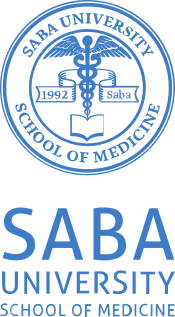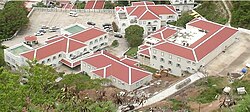| This article contains promotional content. Please help improve it by removing promotional language and inappropriate external links, and by adding encyclopedic text written from a neutral point of view. (November 2023) (Learn how and when to remove this message) |
 | |
| Motto | Education For Life |
|---|---|
| Type | Medical School |
| Established | 1992 |
| President | Cyndi McClaud |
| Location | The Bottom, Saba, Caribbean Netherlands, Netherlands |
| Website | www |
Saba University School of Medicine is a private for-profit offshore medical school located on Saba, a special municipality of the Netherlands in the Caribbean. Saba University confers upon its graduates the Doctor of Medicine (MD) degree. It is owned by R3 Education, Inc. of Devens, Massachusetts, which also owns St. Matthew's University and the Medical University of the Americas.
History
Saba University School of Medicine was founded in 1992 as an international alternative to U.S. and Canadian medical schools. Since its founding, more than 2500 students have earned their medical degree at Saba.
In 2006, the people of Saba, Sint Eustatius and Bonaire agreed to dissolve the Netherlands Antilles. Upon the imminent dissolution of the country, the ministers of health of the Netherlands and the Netherlands Antilles requested the Accreditation Organisation of the Netherlands and Flanders (NVAO) to assess the quality of all medical schools in the Netherlands Antilles. Saba University was the only medical school in the Netherlands Antilles that earned accreditation, and thus was the only medical school to be allowed to stay in those islands.
Curriculum
Basic sciences curriculum
| This section does not cite any sources. Please help improve this section by adding citations to reliable sources. Unsourced material may be challenged and removed. (November 2024) (Learn how and when to remove this message) |

The first five basic science semesters of Saba's curriculum follow an outline comparable to those of American medical schools. These semesters consist of lab work and course material following a progression beginning with foundational concepts in the basic and clinical sciences and leading to organ-systems-focused courses that relate each foundational discipline to human function and disease. Applications of basic science to clinical medicine are highlighted throughout the five semesters. All classes are taught in English.
"Research: Literature Review and Analysis" module
In the fifth semester of the Saba University curriculum, students complete a "Research: Literature Review and Analysis" module, designed to further develop the ability to evaluate and assimilate scientific evidence and reinforce the skills for critically appraising and communicating medical knowledge.
Students analyze a current and complex medical care question, develop a hypothesis, analyze the literature, and write a paper that is evaluated by a faculty committee. According to the school's website, Saba students have had their papers published in medical journals and have also reported that their research played a role in obtaining a residency appointment.
Clinical curriculum
| This section does not cite any sources. Please help improve this section by adding citations to reliable sources. Unsourced material may be challenged and removed. (November 2024) (Learn how and when to remove this message) |
The clinical education at Saba University School of Medicine takes place primarily in the second half of the academic program, semesters 6 to 10—the final semesters before earning the medical degree and entering a residency program. The clinical program consists of:
- 42 weeks of required core rotations in Surgery, Internal Medicine, Pediatrics, Psychiatry, and Obstetrics and Gynecology
- 30 weeks of elective clinical rotations that the student may select based on their projected medical specialty
During the clinical semesters, students go through a series of rotations (or clerkships) in teaching hospitals in the U.S. and Canada, while also absorbing new material through work that is assigned and supervised by the Saba clinical department.
Academic outcomes
According to the U.S. Department of Education, 75% of U.S. medical students completed the MD program on time in 2019. This figure dropped down to 30.43% (14 of 46) in 2023.
Pass rates of its students and graduates on the United States Medical Licensing Examinations (USMLE) in calendar year 2023 were as follows:
Step 1 – Basic Science: 96.88%
Step 2 – Clinical Knowledge (CK): 97.53%
Based on those results, Saba graduates demonstrate Step 1 and Step 2 of their Clinical Knowledge scores portions of the USMLE that are on par to the pass rates among the 110 ranked medical schools as reported by U.S. News Best Medical Schools rankings in 2019:
Step 1 – Basic Science: 96.3%
Step 2 – Clinical Knowledge (CK): 96.6%
Accreditation and licensure
Saba University School of Medicine has received the accreditation and approvals that enable Saba graduates, who complete the requisite licensing examinations, to become eligible to practice medicine in all 50 states in the U.S., Canada and Puerto Rico.
Saba University has been approved by the following U.S. states which have a separate review process for the purposes of licensing or providing clinical rotations:
- Medical Board of California
- Florida Department of Education's Commission for the purpose of students participating in clinical rotations in that state
- New York State Education Department (NYSED) to allow students to complete more than 12 weeks of clinical clerkships in New York State. Saba is one of eight Caribbean medical schools so approved by NYSED.
- Kansas State Board of Healing Arts (KSBHA)
- the United States Department of Education, for participation in the William D. Ford Federal Direct Loan Program. Qualified citizens and permanent residents of the United States are eligible to receive funding from the Direct Loan programs to help pay for the cost of their education.
Saba University School of Medicine is a legally recognized entity of higher education in the Netherlands and its program of medicine is accredited by the Accreditation Organisation of the Netherlands and Flanders (NVAO). While it is located in the Caribbean, accreditation by the NVAO makes the university the 9th medical school in the Kingdom of the Netherlands.
Student loan debt
The US Department of Education reports that the median student loan debt of Americans who attended the school was $284,586 in 2022. Default rate as of 2019 was 0%.
Student life
| This section needs expansion. You can help by adding to it. (November 2016) |
Class sizes are 80-100 students per matriculating class. Students complete the first 20 months (five semesters) of basic science medical education on the campus on Saba and return to the US and Canada to complete clinical rotations at hospitals affiliated with the school.
Numerous student organizations exist at Saba.
See also
References
- ^ "Saba University School of Medicine". Saba University School of Medicine.
- "R3 Education Inc.: Private Company Information - Businessweek". Investing.businessweek.com. Archived from the original on October 15, 2012. Retrieved 2014-02-25.
- "About Saba University". Saba.edu. Archived from the original on 2016-10-23. Retrieved 2016-10-24.
- Radio Netherlands (12 October 2006). "Caribbean islands become Dutch municipalities". Archived from the original on 13 December 2006. Retrieved 2 February 2007.
- ^ "Caribbean_admin, Author at Caribbean Medicine". 20 June 2018.
- "Saba Medical School - Research Module". www.saba.edu. Archived from the original on 2016-12-01. Retrieved 2016-11-30.
- https://studentaid.gov/sites/default/files/saba-university-school-medicine.pdf
- ^ "Saba University School of Medicine". studentaid.gov. US Department of Education. Retrieved 30 July 2023.
- Kowarski, Ilana (4 June 2019). "How to Interpret Med School Licensing Exam Results". www.usnews.com. U.S. News & World Report. Retrieved 8 April 2021.
- "Medical Schools Recognized by the Medical Board of California". Retrieved 9 May 2021.
- "Nonpublic Postsecondary School/College Search". 18 December 2014. Retrieved 9 May 2021.
- "NYS Medicine:Application Forms". www.op.nysed.gov. Archived from the original on 9 May 2021. Retrieved 9 May 2021.
- "NYSED.gov Office of the Professions". Archived from the original on 2021-05-11. Retrieved 2021-05-09.
- "KSBHA". KSBHA. Archived from the original on 2021-05-01. Retrieved 2021-05-09.
- "Home: Understand Aid-Types of Financial AidAid for International Study". U.S. Department of Education.
- "NVAO". Archived from the original on 2015-04-02. Retrieved 2013-04-25.
- "AMSA International Medical Schools". Amsa.org. Archived from the original on 2011-09-27. Retrieved 2011-11-23.
- "Saba University AMSA - Home". Sabaamsa.org. Retrieved 2011-11-23.
External links
| Saba (island) | |||
|---|---|---|---|
| Populated places | |||
| Other locations | |||
| Transport | |||
| Education | |||
| Heraldry | |||
| Culture | |||
| Education in the Dutch Caribbean | |
|---|---|
| Aruba | |
| Bonaire |
|
| Curaçao | |
| Saba | |
| Sint Eustatius | |
| Sint Maarten | |
17°37′33″N 63°14′48″W / 17.625791°N 63.2467°W / 17.625791; -63.2467
Categories: